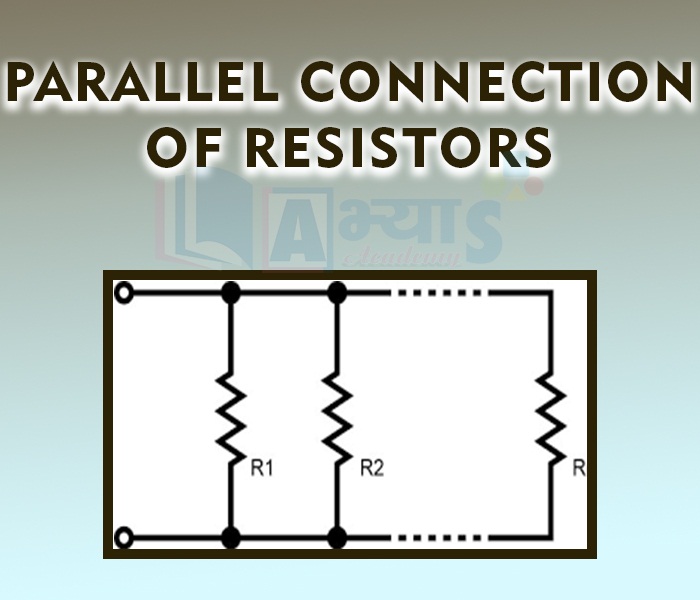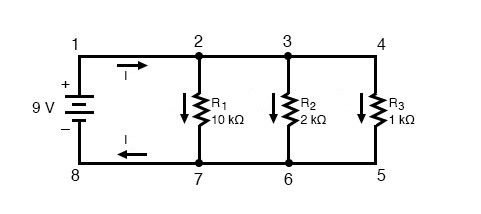Parallel Connection of Resistors






Parallel Connection of Resistors
When two or more resistors are connected simultaneously between two points that is first ends of all the resistors are connected to one point and the all the second ends are connected to the other point, then they form a parallel combination. In this combination, the potential difference between the ends of all the resistances is same but the current is different in different resistance.
In this combination more than one resistance is connected as shown. In this type of circuit:

1. Equal potential difference across each resistance.
2. Total current flowing through the combination is equal to the sum of current flowing through each resistance.
3. Current through each resistance can be calculated using Ohm’s Law and is proportional to the value of resistance.
4. Equivalent resistance is less than resistance of any resistor in the circuit.. This is also known as minimum effective resistance
In the circuit given we have three resistance R1, R2 and R3 are connected in parallel and I1, I2 and I3 are the current flowing through each resistance respectively. If V is the potential difference across the combination the equivalent resistance can be calculated as
Total current is the sum of current flowing through each resistance,then
.....(i)
By Ohm s law,
.....(ii)
If R is the equivalent resistance, then
.....(iii)
Thus the values from equation (2) and (3) in (1) we get
Some important points regarding parallel combination of resistors are as follows :
Parallel combination of resistances is highly useful in circuits used in daily life as the circuits can have components of different resistances and different amounts of current can flow through them. The total resistance in a parallel circuit decreases which helps in the condition that each gadget has different resistances in a circuit and requires different amounts of current to operate. Parallel circuit divides the current among the components (electrical gadgets), so that they can have necessary amount of current to operate properly.
This is the reason of connecting electrical appliances in parallel combination in household circuit.
Illustration: In the circuit given below calculate the current flowing through each resistor.and verify the relationship of current in parallel connections.

Solution: In the circuit we have two resistance R1, R2 and R3 which are connected in parallel to battery of 9 V. The equivalent resistance can be calculated as
Substituting the value of resistance we get
Now as the battery is of 9 V, Then according to Ohm's Law
V= IR
Current through effective resistance (Rp ) is
For parallel combination of resistance, let us verify the relationship
L.H.S. = R.H.S
Hence the relation is verified.
In a circuit if four resistance of 1 ohms, 2 ohms and 3 ohms and 4 ohms are connected in parallel then what is the net resistance | |||
| Right Option : B | |||
| View Explanation | |||
In our houses all electrical devices operate on 220 V it implies that- | |||
| Right Option : A | |||
| View Explanation | |||
In a circuit if three resistance of 3ohms each are connected in parallel then what is the net resistance | |||
| Right Option : C | |||
| View Explanation | |||
Students / Parents Reviews [10]
One of the best institutes to develope a child interest in studies.Provides SST and English knowledge also unlike other institutes. Teachers are co operative and friendly online tests andPPT develope practical knowledge also.

Aman Kumar Shrivastava
10thAbhyas Methodology is very good. It is based on according to student and each child manages accordingly to its properly. Methodology has improved the abilities of students to shine them in future.

Manish Kumar
10thAbout Abhyas metholodology the teachers are very nice and hardworking toward students.The Centre Head Mrs Anu Sethi is also a brilliant teacher.Abhyas has taught me how to overcome problems and has always taken my doubts and suppoeted me.

Shreya Shrivastava
8thI have spent a wonderful time in Abhyas academy. It has made my reasoning more apt, English more stronger and Maths an interesting subject for me. It has given me a habbit of self studying

Yatharthi Sharma
10thMy experience with Abhyas is very good. I have learnt many things here like vedic maths and reasoning also. Teachers here first take our doubts and then there are assignments to verify our weak points.

Shivam Rana
7thAbhyas is a complete education Institute. Here extreme care is taken by teacher with the help of regular exam. Extra classes also conducted by the institute, if the student is weak.

Om Umang
10thA marvelous experience with Abhyas. I am glad to share that my ward has achieved more than enough at the Ambala ABHYAS centre. Years have passed on and more and more he has gained. May the centre flourish and develop day by day by the grace of God.

Archit Segal
7thMy experience was very good with Abhyas academy. I am studying here from 6th class and I am satisfied by its results in my life. I improved a lot here ahead of school syllabus.

Ayan Ghosh
8thMy experience with Abhyas academy is very good. I did not think that my every subject coming here will be so strong. The main thing is that the online tests had made me learn here more things.

Hiya Gupta
8thIt has a great methodology. Students here can get analysis to their test quickly.We can learn easily through PPTs and the testing methods are good. We know that where we have to practice
